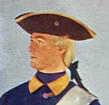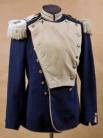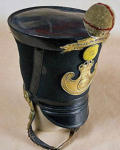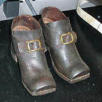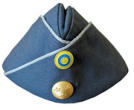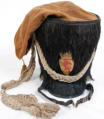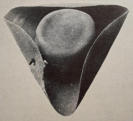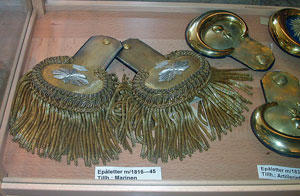

Copyright © Hans Högman 2020-07-23

Uniforms - Nomenclature
The terms below are listed in alphabetical order by
their English names. The Swedish corresponding
names are listed within brackets.
Agraffe (Agraff)
Surgical staples or agreaffes are specialized staples
used in surgery in place of sutures to close skin
wounds. In the Swedish Armed Forces agraffes are
used fasten and display rank insignias and other
badges on military caps. In this respect agraffes are
claps of metal or braids and trimmings in two
pieces which can be hooked together.
Aiguillette (Ägiljett
)
An aiguillette, also spelled aguillette, aiglet or aglet,
is a cord with metal tips or lace tags, or the
decorative tip itself.
In modern usage, an "aiguillette" is an ornamental
braided cord with decorative metal tips worn on
uniforms or as part of other costumes such as
academic dress,[1]
where it will denote an
honour. This usage of
"aiguillette" derives
from lacing used to
fasten plate armor
together. As such, a
knot or loop
arrangement was used
which sometimes hung from the shoulder.
Karlsborgs fästningsmuseum. Foto Hans Högman
2006.
Atilla (Attila)
The atilla is an elaborately braided
Hungarian shell-jacket or short coat,
decorated with lace and knots. Historically
it was part of the uniform of the
Hungarian cavalry known as hussars. The
atilla was made in many styles and many colors
including black, gray, blue, green, red and white.
Some of these overlapped with the Turkish dolman.
The Swedish hussars and artillery enacted the atilla
in the 1850s. In the 1870s it was foremost the
artillery still using atilla.
Banderole (Banderoll)
A baderole was a hanging ornament attached on
headgears, especially on shakos, usually braided
cords.
Battle dress uniform (Fältuniform)
A battledress is a type of uniform used as combat
uniforms, as opposed to dress uniforms or formal
uniform worn at parades and functions. Also known
as combat uniform and is the utility uniform worn
in garrison and in combat zones.
Bigesch
A Bigesch was a long heavily braided greatcoat. The
braiding was in the same color as the greatcoat.
Also, the cuffs were braided.
The bigesch was introduced in the Swedish cavalry
in 1858 and worn by officers and non-
commissioned officers. It then replaced the former
surtout.
Bicorne
The bicorne or bicorn (two-cornered/horned or
twihorn) is a historical form of hat widely adopted
in the 1790s as an item of uniform by European
and American military and naval officers. It is now
most readily associated with Napoléon Bonaparte
but in practice most generals and staff officers of
the Napoleonic period wore bicornes, and it
survived as a widely worn full-dress headdress until
at least 1914.
Breastplate (Bröstharnesk)
A breastplate or chestplate is a device
worn over the torso to protect it from
injury. The Swedish horsemen wore
breastplates (Swe: bröstharnesk) with
a shammy linings (Swe: sämskinn)
until the beginning of the 1700s.
Buff Coat/Jerkin (Kyller)
The European buff coat (the term deriving from the
ox or buffalo hide from which it was commonly
made and its yellowish color) was an item of leather
clothing worn by cavalry and officers during the
17th century, it also saw limited use by some
infantry. It was often worn under armor. It was
derived from the simple leather jerkins worn by
huntsmen and soldiers during the Tudor period,
these in turn deriving from the arming doublet
worn under full plate armor.
Prior to 1700 the Swedish horsemen wore buff
coats (Swe: Kyller) made of moose skin. The buff
coat reached down to the knees.
The reason the buff coat finally was abolished as an
outer garment was the material. The buff coats was
made of moose chamois leather and chamois has a
tendency to attract water and thereafter takes a
long time to dry. Instead of chamois buff coat a
waistcoat of skin was introduced. This waistcoat
was called “camisole” (Swe: kamisol) and had long
sleeves. When the Great Northern War broke out in
1700 the entire Swedish cavalry was equipped with
camisoles instead of buff coats
Burlap (Buldan)
Burlap (Hessian fabric) is a woven fabric usually
made from skin of the jute plant or sisal fibers, to
make rope, nets, and similar products. Gunny is
similar in texture and construction
-C-
Camisole (Kamisol)
Instead of chamois buff coat a waistcoat of skin was
introduced. This waistcoat was called “camisole”
(Swe: kamisol) and had long sleeves. When the
Great Northern War broke out in 1700 the entire
Swedish cavalry was equipped with camisoles
instead of buff coats.
Cartridge box (Kartuschväska)
The cartridge box (pouch) was a box to carry
cartridges. It was worn on the soldier's right hip, on
a belt in front of the soldier's belly ("ventral
cartridge box", "gargoussier"), or on a shoulder
belt. The cartridge box was usually made of stiff
leather or metal. The lid or flap was adorned with
emblems.
Chamois
In color context, chamois is a color with shades of
yellow; yellow, gray-yellow or red-yellow.
Chest Stripes (Bröstrevärer)
Facing on the chest.
Chevron
A chevron (also spelled cheveron, especially in older
documents) is a V-shaped mark, often inverted. The
word is usually used in reference to a kind of fret in
architecture, or to a badge or insignia used in
military or police uniforms to indicate rank or
length of service, or in heraldry and the designs of
flags (see flag terminology).
Cloak (Slängkappa)
A cloak is a type of loose sleeveless
garment that is worn over coats and
serves the same purpose as an overcoat.
Cloaks are generally fasten at the neck or
over the shoulder.
A cape or rather a cloak was also
belonged to the Carolean uniform.
However, the cloak wasn’t fully introduced
in the infantry until the 1690s. The cloak was like
the coat blue and was cut in a circular shape,
sleeveless and equipped with a collar. They were
usually made of wool with a yellow serge lining. The
cloak was kept in place by two buckles in front. The
cloak was 7m (21 ft.) in circumference at the
bottom.
Coat/tunic/blouse (Vapenrock)
A military tunic is a type of medium length coat or
jacket, the lower hem of which reaches down to the
thighs all the way round. It is named after the tunic,
a garment of similar length worn in Ancient Rome.
In the second half of the seventeenth and into the
eighteenth century, European soldiers wore a coat
of a similar style to the civilian justacorps, which
had wide skirts and was decorated with lace at the
front and had broad cuffs. As the eighteenth
century progressed, coats became tighter and
broad lapels to expose the facing color were
introduced, initially in the Prussian Army. The skirts
of the coat were turned back to form tails; this was
initially a mark of the dragoon cavalry, but was
soon adopted by the infantry too.
By the start of the nineteenth century, this had
evolved into a jacket that was cut to waist level at
the front and had a short tail behind; in the British
Army, this was called a "coatee".
By the end of the 1830s, there was a feeling that
uniforms didn't offer soldiers sufficient protection
from the elements or freedom of movement. While
Russia experimented again with the tunic, Prussia
adopted them for their whole army in 1842. The
tunic became almost universal military wear; at the
start of the twentieth century, when the need for
some kind of concealment became apparent,
armies changed to drab colored uniforms.
Cockade (Kokard)
A cockade is a knot of ribbons, or other circular- or
oval-shaped symbol of distinctive colors which is
usually worn on a hat. The cockade was applied on
military and other hats and was cockscomb styled
adornment.
Custodian helmet (Kask)
The custodian helmet was based on the spiked
pickelhaube worn by the Prussian Army.
Czapka (Tschapka)
Czapka (plural: czapki) was a headgear, consisting
of a high, four-pointed cap with
regimental insignia on the front foremost
used by lancers. This headdress
developed initially as a square-topped
variant of a shako.
The Swedish czapka was made of light blue
broadcloth and black leather and equipped with a
white hanging plume of haircloth. The officers’ cap
was equipped with embroideries, silver braids and
pompon of gold. It was a stiff cap with a square
flared crown.
The Swedish Mounted Life Guards wore czapka
between 1852 and 1879.
Dolman (Dolma)
Dolman was a short uniform jacket worn
by hussars. The close fitting, short-cut coat
was heavily braided. It was usually worn
under a pelisse, a similar coat but with fur
trimming, usually worn slung over the left
shoulder with the sleeves hanging loose.
The dolman was extensively adorned with braiding
(often gold or silver for officers) and several rows of
buttons.
The colorful military uniforms of hussars were
inspired by the prevailing Hungarian fashions of the
day.
Dress Uniform (Livmundering)
The “livmundering” was the service dress for use in
the field, i.e. battledress, dress uniform. However,
in the 17th and 18th century the service dress was
also the dress uniform (then equipped with special
uniform details such as plumes etc).
Epaulet (Epålett)
Epaulet is a type of ornamental shoulder piece or
decoration used as insignia of rank by armed forces
and other organizations. In several European
armies, epaulets are also worn by all ranks of elite
or ceremonial units when on parade. Epaulets are
fastened to the shoulder by a shoulder strap, a
small strap parallel to the shoulder seam, and the
button near the collar, or by laces on the underside
of the epaulet passing through holes in the
shoulder of the coat.
The placement of the epaulet, its color and the
length and diameter of its bullion fringe are used to
signify the wearer's rank.
Epaulets first appeared on Swedish uniforms in the
second half of the 18th century. The epaulet was
officially incorporated into Swedish uniform
regulations in 1792, although foreign recruited
regiments had had them earlier. Senior officers
were to wear golden crowns to distinguish their
rank from lower ranking officers who wore golden
stars.
Epaulets were discontinued on the field uniform in
the mid-19th century, switching to rank insignia on
the collar of the uniform jacket. Epaulets were
discontinued when they were removed from the
general issue dress uniform in the 1930s. They are,
however, still worn by
the Royal Lifeguards and
by military bands when
in ceremonial full dress.
Karlsborg Fortress
Museum. Photo Hans
Högman 2006.
Facing (Rockuppslag)
In sewing and tailoring, facing is a small piece of
fabric, separate or a part of the fabric itself, used to
finish the fabric edges. Facing makes a garment
look professionally finished with the seams well
hidden inside the folds of the facing. Facing is
mostly used to finish the edges in necklines,
armholes, hems and openings. They are also used
widely in all other sewing like quilts and home
decor items like curtain hems.
There are basically three types of facing. 1. Shaped
facing 2. Extended facing 3. Bias facing.
Shaped facings are cut to match the outside shape
of the piece to provide a neat finish, and are often
cut from the same pattern pieces. Shaped facings
are typically made of the same fabric as the
garment, but may also be made of lighter-weight
fabric or in a contrasting color as a design element.
Extended facings are extensions of the garment
fabric, folded back and usually stabilized. Bias
facings are strips of lightweight fabric cut on the
true bias (US) or cross-grain (UK), and shaped
rather than cut to match the edge to which they are
applied
Facing Colors
During the 19th century several regiments and
corps of the Swedish Army had an allotted facing
color. A facing color is a common tailoring
technique for European military uniforms where
the visible inside lining of a standard military jacket,
coat or tunic is of a different color to that of the
garment itself.
The jacket lining evolved to be of different colored
material, then of specific hues. Accordingly when
the material was turned back on itself: the cuffs,
lapels and tails of the jacket exposed the
contrasting colors of the lining or facings, enabling
ready visual distinction of different units:
regiments, divisions or battalions each with their
own specific and prominent colors.
Fascine knife (Faskinkniv)
The fascine knife was a side arm / tool issued to
17th to 19th century light infantry and artillery. It
served both as a personal weapon and as a tool for
cutting fascines (bundles of sticks used to
strengthen the sides of trenches or earth ramparts
protecting the batteries).
Fatigue Uniform (Lägermundering)
The fatigue uniform was a simple work uniform
used when it wasn’t suitable to wear the regular
uniform such as duties that would expose them to
field conditions and/or greasy and grimy jobs.
Forage Cap (Lägermössa)
Forage cap is the designation given to various types
of military undress, fatigue or working headgear.
These varied widely in form, according to country
or period. The colored peaked cap worn by the
modern British Army for parade and other dress
occasions is known as a forage cap.
In the 18th century, forage caps were small cloth
caps worn by British cavalrymen when undertaking
work duties such as foraging for food for their
horses. The term was later applied to undress caps
worn by men of all branches and regiments as a
substitute for the full dress headdress.
Frock Coat (Lång kappa)
A frock coat is a man's coat characterized by a knee-
length skirt (often cut just above the knee) all
around the base. The frock coat is a fitted, long-
sleeved coat with a center vent at the back and with
a reverse collar and lapels, where the outer edge of
the lapel is cut from a separate piece of cloth from
the main body, and also a high degree of waist
suppression, where the coat's diameter round the
waist is much less than round the chest. This is
achieved by a high horizontal waist seam with side
bodies, which are extra panels of fabric above the
waist used to pull in the naturally cylindrical drape.
Frock coats emerged during the Napoleonic Wars,
where they were worn by officers in the Austrian
and various German armies during campaign. They
efficiently kept the wearer warm as well as
protected his uniform. Privates and non-
commissioned officers would wear greatcoats on
campaign.
Front plate on caps (Mössplåt)
A metal or wollen plate/badge fixed in-front of hats
and caps as an adornment.
Full dress uniform (Trupparaddräkt)
Full dress uniform is the most formal military
uniform reserved for parade or other ceremonial or
formal occasions.
Gaiter (Stiblett/Damask)
Gaiters are garments worn over the shoe and lower
pants leg, and used primarily as personal protective
equipment; similar garments used primarily for
display are spats. The Swedish army was using
knee-high gaiters in the end of the 1700s. The
gaiters were buttoned up on the outer side of the
gaiters.
Gauntlet (Kraghandske)
A gauntlet is a name for several different styles of
glove, particularly those with an extended cuff
covering part of the forearm. Gauntlets exist in
many forms, ranging from flexible fabric and
leather gloves, to mail and fully articulated plate
armor.
Gorget (Ringkrage)
Gorgets were were worn by officers both as a
badge of rank and an indication that they were on
duty. As early as 1688, regulations provided for the
wearing of gorgets by Swedish army officers. For
those of captain's rank the gorget was gilt with the
king's monogram under a crown in blue enamel,
while more junior officers wore silver-plated
gorgets with the initials in gold. The gorget was
discontinued as a rank insignia for Swedish officers
in the Swedish Armed Forces as of 1792, when
epaulettes were introduced. However, use of the
gorget was revived in 1799, when the Officer of the
day was given the privilege of wearing a gorget
which featured the Swedish lesser coat of arms. It
has since been a part of the officer's uniform (when
he or she functions as "Officer of the day"), a
custom which continues to this day.
The officer of the day
(OOD) is a detail rotated
each day among the
unit/post's officers. The
OOD oversees security,
guard, and law
enforcement
considerations as well as
conducts inspections of dining facilities.
The image shows a Swedish captain’s gorget from
the middle of the 1700s. Digital Museum.
Greatcoat (Kappa)
A greatcoat is a heavy overcoat worn by men in the
armed forces. It is also known as a outercoat or
watchcoat, is a large overcoat that is typically made
of wool designed for warmth and protection
against the weather. Its collar and cuffs can be
turned out to protect the face and hands from cold
and rain, and the short cape around the shoulders
provides extra warmth and repels rainwater (if
made of a waterproof material). It was popular in
the 19th century as a military uniform and casual
wear for the wealthy, and is still issued for
inclement weather by many armed forces around
the world. The coat generally
hangs down below the knees. It
is typically colored gray, though
other colors may be used (e.g.
black, brown, navy blue).
The image to the right shows
Royal Air Force officers wearing
greatcoats, WWII. Wikipedia.
-H-
Hair pouch (Hårpung)
The hårpung (hair pouch) was an accessory to the
uniform and was introduced in 1681. The hair cloth
was a small black pouch made of linen or cotton
which was used to cover the soldiers’ long hair at
the back of their heads or down the back of the
soldiers. The soldiers were to comb their
hair to their back and cover it in these
bags. The Swedish hårpung literately
means hair pouch. Image; soldier
wearing a hair pouch.
Haircloth (Tagel)
Haircloth is a stiff, unsupple fabric typically made
from horsehair and/or from the wooly hair of a
camel. Although horsehair generally refers to the
hair of a horse's mane or tail, haircloth itself is
sometimes called horsehair. Horse or camel hair
woven into haircloth may be fashioned into clothing
or upholstery.
Hosor
Long stockings.
Jackboots (Kragstövlar)
A jackboot is a military boot such as the cavalry
jackboot or the hobnailed jackboot. The hobnailed
jackboot has a different design and function than
the first type. It is a combat boot that is designed
for marching. It rises to mid-calf or higher with no
laces and usually has a leather sole with hobnails.
The term originally denoted tall winged leather
cavalry boots, which had been "jacked", or
reinforced against sword blows by use of mail
(armor) sewn into the lining of the leather. The
wings on these high boots particularly protected a
rider's knee-joint from a sword blow.
The Swedish cavalry used high grain-leather
jackboots. The boots has stiff bootlegs (Swe:
stövelskaft).
Kapott
Greatcoat with sleeves introduced in the Swedish
Army 1806-1807.
Kardong
Brass or leather straps used as adornment on
military hats.
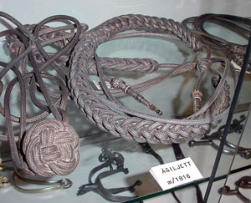





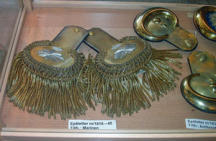
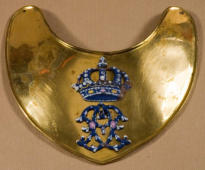


Uniforms of the Swedish
Army - Nomenclature
Karpus
In the early period of the Carolean
Army (1670-1706) , the soldiers
wore a headgear known as karpus.
A karpus was a circular, padded or
fur-lined hat with ear-muffs that could be let down to
cover forehead, ears and the nape of the neck. The
Karpus was mainly used by the soldiers of rank and
file. Officers wore hats. The hat was soft, three-
cornered, had a low crown and turned up brim.
“Knapphål” - Flaps on collar and cuffs
“Knapphål” is a Swedish military term for the ribbons,
stripes and braids fixed around buttons and
buttonholes on facings and above all on cuffs.
“Knapphål” literally means “buttonhole”.
Kollett
The kollett was a type of jacket shorter
than the coat, had a standing collar but no
tails. The kollett was used during
summers and drill exercises. The
corresponding garment in English is
probably coatee. A coatee was a type of
short tight fitting uniform coat or jacket.
Kepi (Käppi)
The kepi is a cap with a flat circular top and
a peak, or visor.
Kurtka
Lancers typically wore a double-breasted jacket
(kurtka) with a colored panel (plastron) at the front,
a colored sash, and a square-topped Polish cap
(czapka). The kurtka was a type of close fitting double
breasted jacket, cut to the waist and often worn with
a plastron, a contrasting-coloured panel of cloth
covering the chest worn by lancers.
The Swedish kurtka was double-breasted with
plastron and piping and equipped with epaulettes.
-L-
Lampasses (Revärer)
Lampasse(s) or trouser stripes are in a large number
of national armed forces trouser stripes. In German
speaking countries as General Staff–qualified
officers, their uniform featured these distinctive
double-wide lampasses. Because of the similar
spelling, it should not be mixed up with the Lampas
(French: Lampas).) which is of different meaning.
Leggings (Charivader)
A kind of long stocking which reached far up onto the
thighs onto of the trousers. Usage from the 18th
century refers to men's wear, usually made of cloth
or leather that is wrapped around the leg down to
the ankle. Leggings refer to several types of leg
coverings.
Linen Weave (Lärft)
Plain weave (also called tabby weave, linen weave or
taffeta weave) is the most basic of three fundamental
types of textile weaves. In plain weave, the warp and
weft are aligned so they form a simple criss-cross
pattern. Each weft thread crosses the warp threads
by going over one, then under the next, and so on.
The next weft thread goes under the warp threads
that its neighbor went over, and vice versa.
Long-coat (Långrock)
The Swedish long-coat was of type
Justaucorps. The long-coat with its long
tails was a bit uncomfortable to wear. The
tails reached down to the knees and were
a hindrance in combat. The tails were also
troublesome for foot soldiers during
march and for horsemen while riding.
Therefor it was common to turn up the tails in front
as well as at the back at each side and onto a buckle.
The coat lining thereby became visible. At other
occasions the tails were let down. The long-coat
reached down to the knees.
The long-coat was generally introduced in Sweden in
the 1680s even if they also can be found in the
1670s.
The long-coat tails were not turned up in the artillery
as they normally were in the infantry and cavalry.
Mantel
Sleeveless coat, cloak.
Medium Blue (Mellanblå)
A shade of blue typical for the Carolean uniforms of
the 1700s.
Other Ranks
The term used to refer to all ranks below officers is
"other ranks" (abbreviated "ORs"). It includes warrant
officers, non-commissioned officers ("NCOs") and
ordinary soldiers with the rank of private or
regimental equivalent. Officers may, in speaking,
distinguish themselves from those "in the ranks".
-P-
Peaked Cap (Skärmmössa)
A peaked cap/visor cap is a form of
headgear worn by the armed forces of
many nations, as well as many
uniformed civilian organizations such
as law enforcement agencies and fire departments. It
derives its name from its short visor (American
English, known as a peak in British English), which
was historically made of polished leather but
increasingly is made of a synthetic substitute.
Pigtail (Stångpiska)
In the context of hairstyles, the usage of
the term pigtail (or twintail or twin tail)
shows considerable variation. The term
may refer to a single braid, but when
used in the plural it often refers to twin
bunches of hair on opposite sides of the head. From
the later 17th century through the 19th century, the
term came to be applied to any braided ("plaited", in
British parlance) hairstyle. The British army also
adopted a single pigtail or "queue" as its standard
dress for long hair. The Swedish Army soldiers used
pigtail in the 1700s with black braids.
Pikeman (Pikenerare)
A pike is a pole weapon, a very long thrusting spear
formerly used extensively by infantry. Unlike many
similar weapons, the pike is not intended to be
thrown.
Piping (Passpoal)
In sewing, piping is a type of trim or embellishment
consisting of a strip of folded fabric so as to form a
"pipe" inserted into a seam to define the edges or
style lines of a garment or other textile object.
Usually the fabric strip is cut on the bias. It may be
made from either self-fabric (the same fabric as the
object to be ornamented) or contrasting fabric, or of
leather.
Plastron (Bröstrevärer)
A plastron is a contrasting-colored panel
of cloth covering the chest. See image to
the right.
Plume (Plym)
A plume is a special type of bird feather, possessed
by egrets, ostriches, birds of paradise, quetzals,
pheasants and peacocks. They often have a
decorative or ornamental purpose, commonly used
among marching bands and the military, worn on the
hat or helmet of the wearer. When used on military
headdresses, the clipped feather plume is referred to
as the hackle.
Pompon (Pompong)
A pom-pom – also spelled pom-pon, pompom or
pompon – is a decorative ball or tuft. In military
context the term refers to a small, tighter ball or tuft
attached to the top of a hat. Pom-poms may come in
many colors, sizes, and varieties and are made from
a wide array of materials, including wool, cotton,
thread and occasionally feathers.
In reference to military uniforms, the small pom-pom
on the crown of military hats is called a "toorie" in
Scotland.
Rank Insignias (Gradbeteckningar)
Rank insignias are worn on military uniforms to
denote the wearers rank.
Trouser stripes / Lampasses (Revärer)
Lampasse(s) are in a large number of national armed
forces trouser stripes. Lampasses are worn even
today in a large number of national armed forces on
dress uniform, full dress uniform, or duty uniform of
general officers. The gold-coloured lampasses of the
US-Cavalry is also well known. Lampasses were fixed
along the seam of the outer side of trousers.
Tunic (Vapenrock)
A military tunic is a type of medium length coat or
jacket, the lower hem of which reaches down to the
thighs all the way round. It is named after the tunic, a
garment of similar length worn in Ancient Rome.
-S-
Serge (Boj)
Serge (Swedish: Boj) is a type of twill fabric that has
diagonal lines or ridges on both sides, made with a
two-up, two-down weave. The worsted variety is
used in making military uniforms, suits, great coats
and trench coats.
Service Dress Uniform (Daglig dräkt)
Service dress uniform is a style of military uniform
that is the equivalent of a business suit, i.e. dress
clothes - not the very most formal attire yet not
casual attire either, but rather pertaining to the
traditional Western dress code of informal attire.
Shako (Tschakå)
A shako is a tall, cylindrical military cap,
usually with a visor, and sometimes
tapered at the top. It is usually
adorned with some kind of ornamental
plate or badge on the front, metallic or
otherwise, and often has a feather,
plume (see hackle), or pompom
attached at the top.
The shako introduced into the Swedish infantry in
1815 was the Russian shako - the kiwa; The kiwa (also
kiver) was a style of shako introduced into the
Imperial Russian Army in 1812; its distinguishing
feature was the dished or concave top. A new shako
was enacted by the Swedish Army in 1838. This
shako was taller and straight upright and didn’t
weight as much as the old one.
Shoes (Skor)
The early infantry footwear was shoes, usually with a
decorative buckle. The shoes were made of grain-
leather (smorläder) and each shoe could
be worn on either foot (no differences
between left and right shoe). The shoes
were black and broken right off in front,
i.e. square toecaps.
Shoulder belt (Koppel)
In military uniforms, a shoulder belt is a wide belt
worn usually over the shoulder and across the body.
A shoulder belt was worn in various configurations,
depending on army and rank. For example, an officer
may have only worn one shoulder belt as
appropriate for only having a pistol.
Shoulder mark (Axelträns)
A shoulder mark, also called an epaulette, shoulder
board, rank slide, or slip-on , is a flat cloth sleeve
worn on the shoulder strap of a uniform. It may bear
rank or other insignia.
Shoulder Straps (Axelklaff)
Many military uniform shirts, jackets, tunics, or
greatcoats feature shoulder straps. They were
originally designed to keep back packs, ammunition
pouches or bayonets from slipping off the shoulder.
They often display badges of rank, shoulder marks,
regimental insignia or epaulets.
The Carolean uniforms had shoulder straps affixed
on the shoulders. Musketeers had two straps, one on
each shoulder; one to keep the bandoleer to the
cartridge pouch in place, the other shoulder strap
was to keep the musket in place on the shoulder. The
pikemen had only one shoulder strap on the right
shoulder to keep the sword belt in place.
Side cap (Båtmössa)
A side cap is a foldable military cap with straight
sides and a creased or hollow crown
sloping to the back where it is
parted. It is known as a garrison cap
or flight cap in the United States,
wedge cap in Canada) or field
service cap in the United Kingdom.
Standing Collar (Ståndkrage)
Standing or stand-up, fitting up around the neck and
not lying on the shoulders. Collars may also be
stiffened, traditionally with starch; A stiff standing
collar for men's formal wear, differentiated from
other tall styles by the lack of tabs at the front.
Stockings (Knästrumpor)
The stockings (knee socks) reached above the
knees and usually made of knitted of wool. They
were kept in place by straps and brass clasps. It was
common to wear two pair of stockings on top of each
other. The stockings were normally yellow but there
were variations: For example the Närke-Värmlands
and Jönköping regiments wore red stockings and the
Västerbotten regiment wore white stockings. Mid-
1690s a special type of protective stocking was
introduced to be worn on top of the ordinary
stockings. These protective stockings was made of
broadcloth or frieze (vadmal) for winter usage and
linen for summer usage. These outer stockings were
predecessor to the gaithers (spats). At the end of the
1690s a new regulation stated that the stockings was
to be in the same color as respective regiment’s color
of the lining.
Surtout (Syrtut)
A surtout is a long greatcoat with lapels and
equipped with one or two rows of buttons worn over
the military uniforms used in the 1700s and 1800s.
-T-
“Tagelliggare”
A tagelliggare was a large crest or comb (lying plume)
made of horsehair (haircloth) used as adornments
on hats and helmets.
Tailcoat (Frack)
A tailcoat is a coat with the front of the skirt cut away,
so as to leave only the rear section of the skirt,
known as the tails. The historical reason coats were
cut this way was to make it easier for the wearer to
ride a horse, but over the years tailcoats of varying
types have evolved into forms of formal dress for
both day and evening wear.
Tails (Skört)
A tailcoat is a coat with the front of the skirt cut away,
so as to leave only the rear section of the skirt,
known as the tails. The historical reason coats were
cut this way was to make it easier for the wearer to
ride a horse, but over the years tailcoats of varying
types have evolved into forms of formal dress for
both day and evening wear.
Tolpak
A high peaked cap made of haircloth
equipped with a hanging pouch of linen
known as a flame and a banderole and
high plume. This cap was usually worn
by the hussars. It was initially
introduced in Sweden mid-1700s.
Three-cornered hat, tricorne
The early Carolean hat had initially
flat brims but later turned up,
however not fastened. At the end of
the 1600s the hat was pinned up on
either side of the head and at the
back, producing a triangular shape.
Hats of this general style were referred to as "cocked
hats". This three-cornered hat is also known as
tricorne.
There was a button on the left brim. The NCOs
button were silver-plated while the officers button
were gold-plated.
The hat was typically worn with one point facing
forward, though it was not at all unusual for soldiers,
who would often rest a rifle or musket on their left
shoulder, to wear the tricorne pointed above their
left eyebrow to allow better clearance.
Trimming (Bräm)
Trim or trimming in clothing is applied ornament,
such as gimp, passementerie, ribbon, ruffles, or, as a
verb, to apply such ornament.
Trousers/Breeches (Byxor/knäbyxor)
Until the end of the 1700s, beginning of the 1800s
trousers were so-called breeches, i.e. they reached
down to the knees. The breeches were tight and
made of skin, sometimes of broadcloth and normally
yellow.
Träns
Braids or cords used as adornments on uniforms.
Undress Uniform/Dress Cloths
(Släpmundering)
Dress clothes (undress) are clothing that is less
formal than the service dress (field uniform). In other
words an informal working dress/uniform.
Uniform Cloth (Kommiss)
Cloth used for military uniforms (Swedish: Kommiss).
-W/V-
Wadmal / Frieze (Vadmal)
Wadmal is a coarse, dense, usually undyed wool
fabric woven in Iceland, Norway, Sweden, Greenland,
and the Orkney, Faroe and Shetland Islands from the
Middle Ages into the 18th century. In remote
regions, wadmal remained the primary fabric for
working people's clothing into the 18th century.
Worsted (Redgarn/kamgarn)
Worsted is a high-quality type of wool yarn, the fabric
made from this yarn, and a yarn weight category. The
name derives from Worstead, a village in the English
county of Norfolk.
Vest (Väst)
The vest (waistcoat) reached down to the knees, was
made of skin and generally yellow. There were vests
also made of broadcloth even if they weren’t
common.






